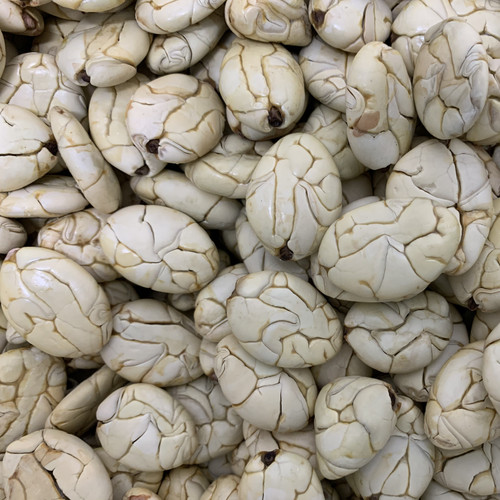Description
In the Ecuadorian Amazon, generations of indigenous farmers have
harvested and cultivated macambo, also known as Jaguar Cacao Beans, from tall rainforest trees.
It is a hidden gem, a close but distinctive relative of cacao,
with a delicate white bean. Its scientific name, Theobroma bicolor,
points to this close relationship with cacao, though it has
important differences.
Macambo is currently grown near the earliest archaeological site
with evidence of cacao consumption dating back 5,000 years. With
its tasty pulp and large, edible seeds, macambo was very likely
discovered and domesticated at around the same time as cacao by
ancient Indigenous inhabitants of the Amazon basin.
Jaguar Cacao is known as macambo, but also as patasmuyo, kila, wakam,
bacao. paxate, and cacao blanco.
We work together with Canopy Bridge, an Ecuadorian company dedicated to supporting
communities who conserve biodiversity by developing innovative
traditional products for market.
USES
Our macambo beans are roasted at low temperatures,
allowing chocolate makers and chefs latitude to
develop the flavor and aroma profile to their
specifications through additional roasting. We can
provide custom roasting on request.
Chocolate making
When worked like cacao beans for true chocolate, the
nutty macambo beans alone can create a delicate
“white” bar. Or, processed together with cacao, can
lead to a smooth, milky bar – without any dairy.
Whole beans can also be covered in chocolate,
playing with the contrast of these two related beans
from the cocoa family. Macambo nibs, with their
nuttiness, slight fruitiness and crunchy texture can
also be used as an inclusion in chocolate bars.
Macambo beans have about half the fat of cocoa
beans, which may require adding cocoa butter (or
another fat or oil) for conching and melanging
As nuts in other culinary uses
Though not in the true botanical sense a nut (but
rather, a seed), macambo beans are spectacular in
any recipe calling for nuts for flavor and texture,
including tarts and other desserts, nut butters and
pralines, sauces, soups and garnishes for both sweet
and savory dishes.
IMPACT: TREES THAT SUSTAIN
In Ecuador, our macambo is grown by indigenous
farmers from the Kichwa and Shuar nations who have
conserved productive trees for decades.
Ninety percent of macambo farmers are women, and
macambo is providing them with their own incomes
which they typically reinvest in family needs like health
and education for their children.
For the uninitiated, these indigenous farms, known as
chakras in the local Kichwa language, are
indistinguishable from rainforest. Farms are dense and
diverse, with dozens of plant species from tall canopy
trees filtering the light to understory bushes, climbing
vines and ground-hugging herbs. Each tree and plant
traditionally has its use and place in maintaining the
cycle of nutrients and web of life in the fragile rainforest
environment, yielding food, medicine, building
materials, dyes and countless other uses.
Macambo trees are found scattered across these forest
farms, typically planted years ago by the grandmothers
and mothers of the farmers who harvest the macambo
pods today. Until recently, macambo harvest and
consumption was falling into decline, part of a broader
pattern of local communities abandoning healthy
traditional foods for modern diets. Canopy Bridge
provides nutrition and cooking workshops to promote a
resurgence in the use of macambo and other healthy
traditional foods.
By selling a portion of their macambo harvest, which
was previously left to spoil on the forest floor, women
farmers are seeing new value from conserving this and
other traditional crops. They have boosted their incomes
and have begun to value anew macambo as a healthy
and delicious local food, consumed in stews, roasted
and fried. Slowly and carefully, they are recovering
abandoned trees and incorporating a new generation of
macambo into the mix of their chakras, with support
from nurseries and tree-planting programs together
with Canopy Bridge.









